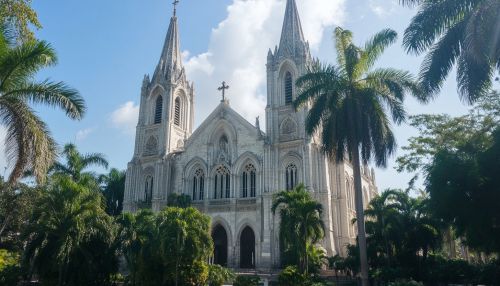Port-au-Prince Cathedral
History
Port-au-Prince Cathedral, also known as the Cathedral of Our Lady of the Assumption, is a Roman Catholic cathedral located in Port-au-Prince, the capital city of Haiti. The cathedral has been a central figure in the religious and cultural life of Haiti since its establishment. Its history is marked by significant events, including natural disasters and social upheavals, which have shaped its current form and status.
The cathedral was originally constructed in the late 19th century, with its cornerstone laid in 1884. The construction was completed in 1914, and the cathedral was consecrated in the same year. The architectural design of the cathedral was influenced by French Gothic Revival architecture, which was a popular style during that period. The cathedral's intricate facade, towering spires, and stained glass windows were notable features that attracted both worshippers and tourists.


Architectural Features
The Port-au-Prince Cathedral was renowned for its architectural grandeur. The design incorporated elements of Gothic Revival architecture, characterized by pointed arches, ribbed vaults, and flying buttresses. The cathedral's facade featured elaborate stone carvings and statues, depicting various saints and biblical scenes.
The interior of the cathedral was equally impressive, with a high vaulted ceiling supported by a series of columns and arches. The nave was spacious, allowing for large congregations during religious ceremonies. The stained glass windows were a highlight, depicting scenes from the life of Christ and various saints. These windows were not only decorative but also served to educate the faithful about the stories and teachings of the Church.
The cathedral also housed a significant pipe organ, which was used during liturgical services and special events. The acoustics of the building were carefully designed to enhance the sound of the organ and the choir, creating a reverberant and uplifting atmosphere.
Cultural and Religious Significance
Port-au-Prince Cathedral has played a vital role in the religious life of Haiti. As the seat of the Archdiocese of Port-au-Prince, it has been the center of numerous important religious events, including ordinations, confirmations, and major liturgical celebrations. The cathedral has also been a place of pilgrimage for many Haitian Catholics, who visit to seek spiritual solace and participate in communal worship.
Beyond its religious functions, the cathedral has been a symbol of Haitian culture and resilience. It has witnessed and endured through various historical events, including political turmoil and natural disasters. The cathedral's presence in the heart of Port-au-Prince has made it a landmark and a point of reference for the city's inhabitants.
Earthquake of 2010
One of the most significant events in the history of Port-au-Prince Cathedral was the devastating earthquake that struck Haiti on January 12, 2010. The earthquake, which measured 7.0 on the Richter scale, caused widespread destruction across the country, including the collapse of the cathedral.
The earthquake resulted in the loss of many lives, including the Archbishop of Port-au-Prince, Joseph Serge Miot, who was found dead in the rubble. The cathedral itself was severely damaged, with its roof and spires collapsing, leaving only parts of the walls standing. The destruction of the cathedral was a significant blow to the Haitian Catholic community and the nation as a whole.
Reconstruction Efforts
In the aftermath of the earthquake, there were numerous discussions and plans regarding the reconstruction of Port-au-Prince Cathedral. Various international organizations, along with the Haitian government and the Catholic Church, pledged support for the rebuilding efforts. The reconstruction was seen not only as a restoration of a religious building but also as a symbol of hope and resilience for the Haitian people.
Architectural competitions were held to design a new cathedral that would honor the original structure while incorporating modern building techniques to withstand future earthquakes. The new design aimed to preserve the historical and cultural significance of the cathedral while ensuring the safety and durability of the structure.
Current Status
As of the latest updates, the reconstruction of Port-au-Prince Cathedral is ongoing. The project has faced numerous challenges, including funding shortages and logistical difficulties. However, the commitment to rebuilding the cathedral remains strong, with continued support from various stakeholders.
The site of the original cathedral remains a place of reflection and remembrance for many Haitians. Temporary structures have been erected to allow for religious services and community gatherings while the reconstruction efforts continue.
